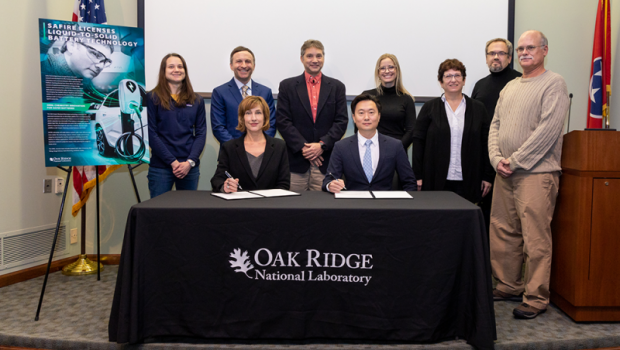Liquid-to-solid Battery Electrolyte Technology Licensed Exclusively to Safire – ORNL
https://www.ispeech.org/text.to.speech
Liquid-to-solid battery electrolyte technology licensed exclusively to Safire – ORNL.
The Department of Energy’s Oak Ridge National Laboratory has exclusively licensed battery electrolyte technology to Safire Technology Group. The collection of five patented technologies is designed for a drop-in additive for lithium-ion batteries that prevents explosions and fire from impact.
Safire, a battery technology startup formerly known as BTRY, plans to locate facilities in East Tennessee as part of its plan to commercialize the liquid-to-solid battery technology.
Susan Hubbard, ORNL deputy for science and technology, said:
“Improving battery technology is critical to building a clean energy future for our country.
“This technology has implications for several industries, ultimately making battery systems safer, more efficient and more stable.”
The potential for battery cells to catch fire or explode when impacted — such as in a car crash — and cause property loss, serious injuries or deaths is a major challenge in the adoption of battery technology for electric vehicles and aircraft, such as unmanned aerial vehicles.
ORNL’s Safe Impact Resistant Electrolyte, or SAFIRE, technology removes this risk through a new electrolyte formulation that changes the electrolyte from liquid to solid upon impact.
In a lithium-ion battery, a thin piece of plastic separates the two electrodes. If the battery is damaged and the plastic layer fails, the electrodes can come into contact and cause the battery’s liquid electrolyte to catch fire. In SAFIRE, the electrolyte solidifies under impact, blocking contact between electrodes.
The technology can significantly reduce vehicle weight and increase range by removing the need for heavy protective shielding around the battery.
John Lee, co-founder and chief executive officer of Safire, said:
SAFIRE will transform the car industry, particularly as we pivot towards electric vehicles.
“The additive is easy to incorporate into existing battery-making processes and provides users with a safer alternative that is lighter and more effective than conventional battery protection, resulting in higher performance and lower total cost of ownership.”
In defense applications, the technology provides projectile and ballistic protection while reducing the weight of defense systems and equipment.
Lee and Mike Grubbs, Safire’s other cofounder, are also partnering with government agencies and industry to develop the technology for electric vertical takeoff and landing, or eVTOL, aircraft, e-bikes and other Li-ion-powered equipment.
Mike Grubbs said during a Nov. 15 licensing event at ORNL:
This announcement further strengthens our long-term collaboration with ORNL and allows us to begin commercial testing.
“We are also exploring new partnerships and identifying prototyping opportunities with automotive, e-bike and eVTOL manufacturers.”
ORNL’s Gabriel Veith, the inventor of SAFIRE, has been working to develop and refine the battery technology since 2014. Veith has been named in two R&D 100 Awards, including one for SAFIRE. The development team also includes ORNL colleagues Beth Armstrong, Hsin Wang, Sergiy Kalnaus, Katie Browning and Kevin Cooley.
Gabriel Veith said:
The best part of working at ORNL is the team environment.
” This team has a rheologist, a ceramicist, an electrochemist, mechanics experts, materials testers — all those together make this technology work,” Veith said.
“This is not the work of a single person — teamwork allowed us this really unique opportunity. Having a diversity of people, experiences and backgrounds really helps to develop ideas.”
SAFIRE was originally funded through the ORNL Seed Money program, and the project continued under DOE’s Advanced Research Projects Agency – Energy. The commercialization effort received support from the lab’s Technology Innovation Program as well as FedTech’s Startup Studio, a venture firm program dedicated to advancing deep tech.
Safire plans to start developing prototypes with strategic partners. Parties interested in testing the technology or partnering with Safire should email partnerships@safire.co.
UT-Battelle manages ORNL for the Department of Energy’s Office of Science, the single largest supporter of basic research in the physical sciences in the United States. The Office of Science is working to address some of the most pressing challenges of our time. For more information, please visit energy.gov/science.
READ the latest Batteries News shaping the battery market
Liquid-to-solid battery electrolyte technology licensed exclusively to Safire, November 18, 2022








Gloss